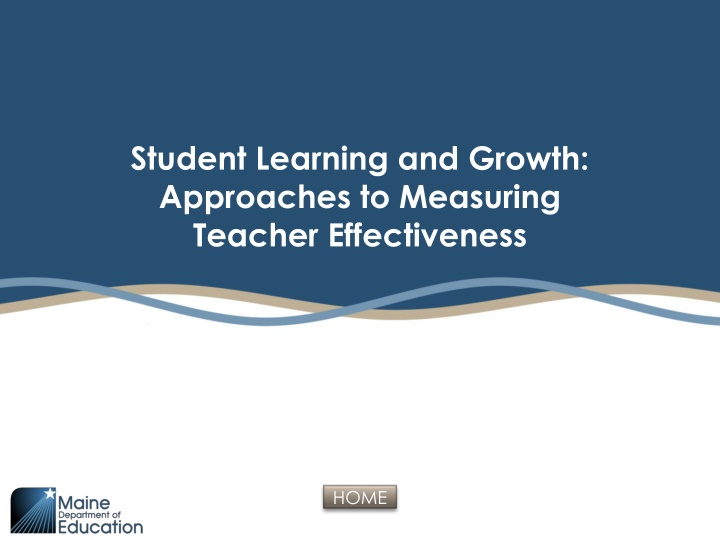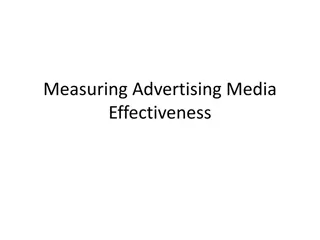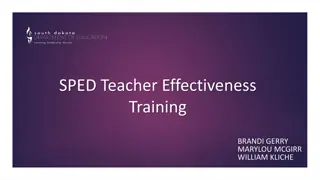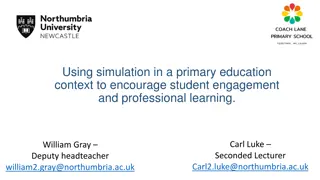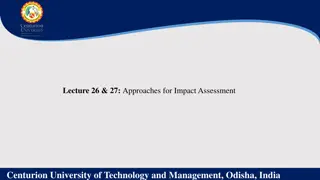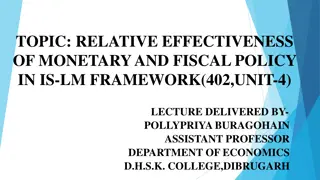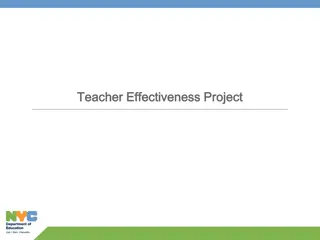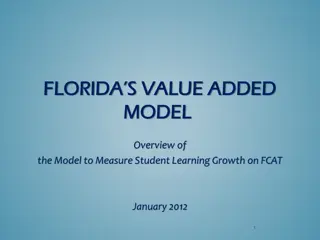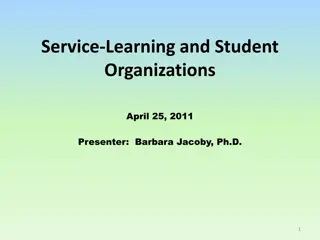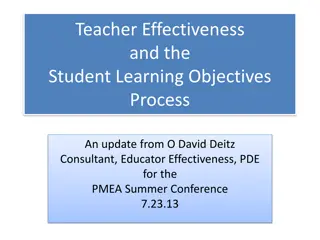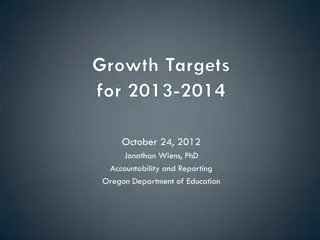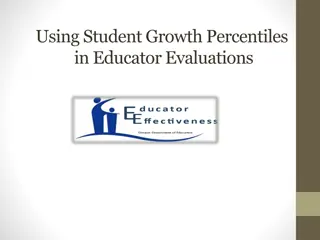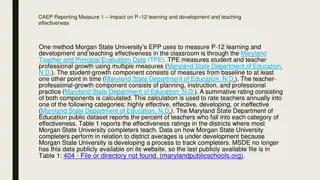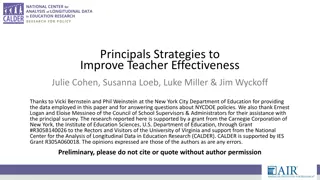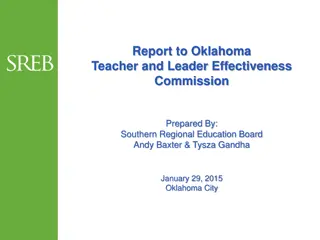Approaches to Measuring Teacher Effectiveness in Student Learning and Growth
This presentation delves into methods for assessing teacher impact on student learning and growth, focusing on the Performance-Gap-Reduction (PGR) approach alongside the Percent-Met method. It covers requirements, sample measures, SLO analysis, FAQs, and local decision-making considerations in evaluating teachers. Important concepts and procedures related to measuring student growth and attributing it to teachers are discussed.
Download Presentation

Please find below an Image/Link to download the presentation.
The content on the website is provided AS IS for your information and personal use only. It may not be sold, licensed, or shared on other websites without obtaining consent from the author.If you encounter any issues during the download, it is possible that the publisher has removed the file from their server.
You are allowed to download the files provided on this website for personal or commercial use, subject to the condition that they are used lawfully. All files are the property of their respective owners.
The content on the website is provided AS IS for your information and personal use only. It may not be sold, licensed, or shared on other websites without obtaining consent from the author.
E N D
Presentation Transcript
Student Learning and Growth: Approaches to Measuring Teacher Effectiveness HOME HOME
Introduction This slide presentation introduces emergent thinking on a method of rating teachers on the student learning and growth component of a performance evaluation and professional growth (PEPG) system. The "Performance-Gap-Reduction" (PGR) method presents both a unique approach to targeting and measuring student growth and to rating teacher impact on that growth. This resource supports districts in understanding both the PGR method and the more commonly used method. The Maine DOE welcomes input and feedback from districts who decide to use either of the methods described in this presentation. HOME HOME HOME HOME 2
Overview of Presentation The primary purpose of this presentation is to provide an analysis of two methods of measuring and rating teachers on student learning and growth. We call these two methods the "Percent-Met" method and the "Performance-Gap- Reduction" method. The presentation includes: An overview of requirements related to measures of student learning and growth Sample methods of combining measures to arrive at a summative rating A review of the components of the SLO A comparison between the SLO and state requirements for student learning and growth An analysis of the two rating methods. FAQs on the Performance Gap Reduction method HOME HOME HOME HOME 3
Overview of Requirements Related to Measures of Student Learning And Growth HOME HOME
Local Decisions Related to the Student Learning and Growth Factor and Rating *The method of determining a teacher's rating on measures of Student Learning and Growth *Procedures for setting growth targets for students Requirements for attribution of student growth to teachers (Teacher(s) of Record; collective attribution) Criteria for size of instructional cohort Criteria for length of instructional interval of time Requirements for number of growth targets per year/summative rating Local requirements for use and development of assessments *Method of recording and monitoring elements of the growth measure, e.g, the Student Learning Objective (SLO) The method of combining student learning and growth with other factors to arrive at a summative rating. *Primary focus of this slide presentation HOME HOME HOME HOME 5
General Requirements and Concepts HOME HOME
Required Measures of Educator Effectiveness Student Learning and Growth Multiple Measures Professional Practice A district may choose to include other measures of effectiveness , such as professional growth or surveys. HOME HOME 7
Defining 'Student Learning and Growth' As a factor in the summative effectiveness rating of a teacher or principal, 'Student Learning and Growth' is based on data that measures a change in an *instructional cohort's academic knowledge and skills between two points of time. *The student or group of students whose academic growth will be attributed to a teacher or principal. HOME HOME 8
Learning and Growth Measure: The Basics Based on Content Standards * Attributed to individual or multiple teachers of record *May be applied outside TOR under certain conditions Growth Measure Requires Pre and post assessment Based on an assessment that meets criteria for "permissible measures" in Rule Chapter 180 HOME HOME HOME HOME 9
Student Learning and Growth as a "Significant Factor" Local Decision: The percentage of an overall summative rating that student learning and growth will comprise is a local decision subject to Maine DOE approval. Maine DOE Parameters: The Educator Effectiveness law requires that in an educator's summative effectiveness rating Student Learning and Growth must be a "significant factor." "To be considered significant, the rating on student learning and growth must have a discernible impact on an educator s summative effectiveness rating" (Rule Chapter 180). Default Percentage: If by June 1, 2015 the local development committee cannot by consensus reach agreement on the percentage that Student learning and Growth will comprise, the default percentage will be 20% in a numeric scale. HOME HOME 10
Methods of Combining Multiple Measures The next three slides illustrate two different methods of combining measures to arrive at a summative rating. The method used is a local decision. HOME HOME
Method 1: Numeric Values and Weights SAMPLE Summative Evaluation Score Table Weighted Results Measure of Effectiveness Results Weight Professional Practice 3.5 X .60 = 2.1 + .3 + Professional Growth 3 X .10 = 3 X .30 .9 Student Learning and Growth = 3.30 Final Summative Score Final Score 3.4 or higher 2.5-3.4 1.5-2.4 Less than 1.5 Summative Effectiveness Rating Distinguished Effective Developing Ineffective HOME HOME 12
Method 2: Criterion-Based Ratings Plotted on Pre-set Matrix See detailed instructions in the Maine DOE T-PEPG Handbook Maine DOE TEPG Summative Performance Rating Matrix Combined Professional Practice and Professional Growth Ineffective DevelopingEffective Distinguished Review Required Highly Effective Highly Effective High Effective Learning and Growth Effective Partially Effective Partially Effective Impact on Student Moderate Effective Partially Effective Partially Effective Review Required Low Ineffective Partially Effective Review Required Negligible Ineffective Ineffective HOME HOME 13
Different Approaches, Same Process Combine Performance Measure Ratings Combine Individual Ratings into Composite Performance Measure Ratings Rate Individual Indicators Rate individual indicators of professional practice Combine ratings on individual indicators of professional practice into a composite professional practice rating (PP Rating) Summative Effectiveness Rating Rate individual measures of student growth (e.g., results of individual SLOs) Combine ratings on individual measures of student growth into a composite student learning and growth rating (SG Rating) Rate individual factors of any other performance categories, e.g., professional growth Combine ratings on individual factors related to any other measures of performance categories into composite rating (e.g., PG Rating) 2 3 1 HOME HOME
The Student Learning Objective (SLO) Framework This purpose of this section is to provide perspective on the role of the Student Learning Objective (SLO) framework in measuring student learning and growth. We include this section because our analysis of the two rating methods has implications for the SLO process. HOME HOME
The Benefits of the SLO Process in a Performance Evaluation and Professional Growth System Performance Evaluation Links student outcomes to individual teachers Professional Growth Adds value and improves practice, as reported by Maine teachers Contains important data, such as roster and teacher(s) of record. Focuses and aligns student needs, learning objectives, instruction and assessment Reduces risk of inaccuracies in roster verification Provides context for important professional conversations and collaboration Allows for flexible grouping and attribution of teachers in a student-centered system Connects to additional readily available resources across the nation HOME HOME 16
The Components of the SLO Document As commonly understood, the SLO is a locally designed document framework that: Always includes Includes depending on method used Optionally includes Roster of instructional cohort and names of teacher(s) of record Identification of students' needs or readiness to meet the standards, based on available data Interval of instructional time Expected learning outcomes and range of possible growth Teacher-developed growth target(S) The Performance Gap Reduction method of measuring growth and rating teachers does not necessitate a teacher-developed growth target, but it does necessitate knowledge of the individual and mean performance gaps as determined by pre and post assessments. Identification of content standards that will be taught and assessed Explicit alignment of content standards to assessment items Identification of pre- and post-assessments Key Instructional Strategies and formative assessment processes Baseline performance on a pre-assessment Post-assessment results HOME HOME 17
Elements of the SLO Required or implicated by Law (The SLO framework itself is not a requirement of the law) HOME HOME
Description of information Typically Entered on SLO Document SLO Sections Teacher of Record Demographics Baseline data and Student Needs Required States the number of students included in the SLO Provides relevant and complete information about student characteristics Includes start and end dates of interval of instructional time YES Identifies area(s) of need Identifies available data used to determine areas of strength and need LOCAL Decision Includes analysis of available data for areas of strength and need Includes standards that align to the area of need and to the assessments Rule Chapter 180 requires that an assessments "Be able to measure growth in identified and intended learning outcomes." Includes both application/process and content standards YES (de facto) LOCAL Decision Content Standards Includes standards that are rigorous but focused enough to be measured using an appropriate assessment Rule Chapter 180 requires that an assessments "Be able to measure growth in identified and intended learning outcomes." Identifies an assessment that aligns with the identified content and process standards. Identifies an assessment that meets all criteria in Rule Chapter 180 (Table 5 of SLO Handbook) YES (de facto) YES YES Box 10 Pre and Summative Assessment LOCAL Decision Describes the format and structure of the assessment Lists modifications or accommodations that will be necessary for students with IEPs or 504 plans and/or ELL students, and explains how the modifications or accommodations will be provided. Rule Chapter 180 requires that an Assessment Be able to measure growth in identified and intended learning outcomes YES (de facto) HOME HOME 19
SLO Sections Required LOCAL Decision Description of information Typically Entered on SLO Document Numerical growth targets for all students on the roster Box 11 Growth Targets Includes targets that are rigorous, attainable, and developmentally appropriate LOCAL Decision LOCAL Decision LOCAL Decision LOCAL Decision LOCAL Decision Includes a rationale for the targets that explains how the growth targets were determined Lists two or three key strategies that the teacher will use to support students. Box 12 Instructional Strategies Identifies multiple ways the teacher will monitor student progress throughout the interval of instruction. Explains how progress monitoring data will drive instructional plans. Describes strategies that will be used to assess learning at anticipated check points and the adjustments to instruction or interventions that might be taken based on results of formative assessment (not all formative assessments and adjustments can be anticipated, but the teacher should have preplanned some formative processes). Box 13 Formative Assessment LOCAL Decision Pre-Approval by Peer(s) Final Approval Signature LOCAL Decision LOCAL Decision HOME HOME 20
Guidance Provided in The Maine DOE SLO Handbook Table 1 Teacher(s) of record and Instructional Cohort Table 2 Student Demographics and Baseline Data Table 3 Interval of Instructional Time Table 4 Curricular Standards Table 5 Assessments Table 6 Growth Targets Table 7 Key Instructional Strategies Table 8 Formative Assessment Processes Table 9 The Approval Process Table 10 Modifications to an SLO Table 11 Implementing the SLO Table 12 Rating the SLO HOME HOME 21
Method of Scoring Student Learning and Growth Measures to Determine Teacher Rating The following slides compare two different methods of measuring student growth and determining a teacher's impact on that growth : The Percent-Met Method The Performance-Gap-Reduction Method HOME HOME
Percent-Met Method Rating Scale* Based on number of students who meet a growth target, which is typically set by the teacher. Percentage Ranges of Students Who Met Their Growth Targets Teacher Impact 85 100% 71 84% 41 70% 0 40% High Moderate Low Negligible Impact on Student Learning and Growth Rating Total of the % of all growth targets met number of SLOs = Average % of students who met the growth target *This Impact scale is used in the Maine DOE Teacher Performance Evaluation and Professional Growth Model, which also uses an SLO frame. The design of the scale represents the widely used method of measuring student growth and rating teacher impact on that growth. In some instances of the use of this method, the rating categories are numeric (e.g. 85-100% = 3.51-4.00 Points). HOME HOME 23
Steps in the Percent-Met Method Step 1: Pre-assess; score Step 2: Teacher sets a growth target for the cohort, using one of multiple approaches (see slide 34) Step 3: Post-assess; score Step 4: Determine how many students met the growth target set for the cohort Step 5: Determine the teacher's impact rating on the % Met Impact Scale HOME HOME 24
Step 1: Pre-Assessment Student Mastery Score Pre-Assessment Score 95 86 222 37 103 214 230 78 87 200 A B C D E F G H I J 250 250 250 250 250 250 250 250 250 250 Assessment: The comprehensive assessment in our sample has a total possible points of 250. HOME HOME 25
Step 2: Teacher Sets Growth Target for the Cohort Target-Setting Guidelines Baseline and pretest data inform developmentally appropriate expectations for students on the summative assessment. Growth targets are informed by knowledge of students, content, and assessments. State and district guidelines help ensure that SLO growth targets are rigorous, attainable, and developmentally appropriate. All students regardless of pre-assessment scores are expected to demonstrate significant and appropriate growth. Student growth targets may be formatted in a variety of ways. Districts may set additional guidelines or requirements related to the formatting of growth targets. The following slide shows sample formats, but not the only formats, for growth targets. Maine DOE and MSFE Guidelines HOME HOME 26
This guide can be found in the Maine DOE Student Learning Objective Handbook HOME HOME 27
Step 2: Continued Growth Target Format: Half-the-Gap Example: All students will increase their scores by one half the difference between 250 and their pre-assessment score; a student who scored 50 on the pre-assessment would be expected to score a 150 on the post-assessment. HOME HOME 28
Step 2: Continued Growth Target Format: Half-the-Gap All students will increase their scores by one half the difference between 250 and their pre-assessment score; a student who scored 50 on the pre-assessment would be expected to score a 150 on the post-assessment. Stude nt Max Score Possible 250 250 250 250 250 250 250 250 250 250 Pre- Assessment Score 95 86 222 37 103 214 230 78 87 200 Performan ce Gap the gap growth target 72.5 82 14 106.5 73.5 18 10 86 81.5 25 A B C D E F G H I J 155 164 28 213 147 36 20 172 163 50 HOME HOME 29
Step 3: Post-assess Student Max Score Possible Pre- Assess ment Score 95 86 222 37 103 214 230 78 87 200 Performance Gap the gap growth target 72.5 82 14 106.5 73.5 18 10 86 81.5 25 Post assessment score A B C D E F G H I J 250 250 250 250 250 250 250 250 250 250 155 164 28 213 147 36 20 172 163 50 194 167 236 135 171 231 240 162 193 229 HOME HOME 30
Step 4: Determine Number of Students who Meet Growth Target Student Max Score Possible Pre- Assess ment Score 95 86 222 37 103 214 230 78 87 200 Performance Gap the gap growth target 72.5 82 14 106.5 73.5 18 10 86 81.5 25 Post assessment score Growth gain Met target Yes/no A B C D E F G H I J 250 250 250 250 250 250 250 250 250 250 155 164 28 213 147 36 20 172 163 50 99 81 14 98 68 17 10 84 106 29 194 167 236 135 171 231 240 162 193 229 Y N Y N N N Y N Y Y 5/10 50% of students met growth target HOME HOME 31
Step 5: Determine the Teacher's Impact Rating on the Percent-Met Scale Percentage Ranges of Students Who Met Their Growth Targets Teacher Impact High Moderate Low Negligible 85 100% 71 84% 41 70% 0 40% Impact on Student Learning and Growth Rating Total of the % of all growth targets met number of SLOs = Average % of students who met the growth target HOME HOME 32
Some Implications of Setting Growth Targets The SLO typically includes a teacher-developed growth target. The growth target element of the SLO process requires: The need for training in setting of growth targets A mechanism for ensuring comparability, fairness, and accuracy A mechanism for safeguarding against conflicts of interest An approval agent well-versed in growth targets HOME HOME 33
A Closer Look at the Percent-Met Method The following slides illustrate possible outcomes of the Percent-Met method. HOME HOME
Comparing Percent Targets Met in Two Like Cohorts Teacher 1 Growth Teacher 2 Growth A 150 /157 y 7 A 150/162 y 12 Two like teachers Illustration based on use of individual growth targets (GTs) converted to mean GT of 6 B 170/176 y 6 B 170/189 y 19 C 175/163 n -12 C 175/180 n 5 D 180/187 y 7 D 180/194 y 14 E 190/186 n -4 E 190/193 n 3 F 195/203 y 8 F 195/213 y 18 % Met Growth Target 4 of 6 66%..................................................................................................4 of 6 66% Same number of students meet the growth target HOME HOME 35
Percent-met Rating Scale Percentage Ranges of Students Who Met Their Growth Targets High Moderate Low Negligible 85 100% 71 84% 41 70% 0 40% Teacher 1 and Teacher 2 Same rating on Percent-Met Scale Impact on Student Learning and Growth Rating Total of the % of all growth targets met number of SLOs = Average % of students who met the growth target HOME HOME 36
Comparing Actual Growth Teacher 1 Growth Teacher 2 Growth A 150 /157 y 7 A 150/162 y 12 B 170/176 y 6 B 170/189 y 19 C 175/163 n -12 C 175/180 n 5 D 180/187 y 7 D 180/194 y 14 E 190/186 n -4 E 190/193 n 3 F 195/203 y 8 4 12 4 71 F 195/213 y 18 % Met Growth Target 4 of 6 66%..................................................................................................4 of 6 66% Mean Growth 12 6 = 2.00 ..71 6 =11.83 Different amount of actual growth occurs. HOME HOME 37
Comparing Percent-met with Actual Growth Teacher 1 Growth Teacher 2 Growth A 150 /157 y 7 A 150/164 y 14 B 170/176 y 6 B 170/189 y 19 C 175/163 n -12 C 175/180 n 5 D 180/187 y 7 D 180/194 y 14 E 190/196 y 6 E 190/195 n 5 F 195/203 y 8 5 22 4 75 F 195/213 y 18 % Met Growth Target 5 of 6 83%..................................................................................................4 of 6 66% Mean Growth 22 6 = 3.66 ..75 6 =12.50 Different amount of actual growth occurs. HOME HOME 38
Percent-Met Rating Scale Percentage Ranges of Students Who Met Their Growth Targets High Moderate Low Negligible 85 100% 71 84% 41 70% 0 40% Teacher 1 Teacher 2 Impact on Student Learning and Growth Rating Total of the % of all growth targets met number of SLOs = Average % of students who met the growth target Teacher 1 is rated as having greater growth impact than Teacher 2 even though teacher 2 s instructional cohort has more than three times the mean growth as Teacher 1 s instructional cohort. HOME HOME 39
Summary of A Closer Look at the Percent-Met Method The percent-met method of arriving at a teacher's Student Learning and Growth uses a binary, yes or no, target that does not account for all of the growth attained (or not attained) by students in a cohort. When all factors are made equal, the Percent-Met method cannot distinguish between two teachers with significantly different actual growth. When all factors are made equal, the Percent-Met method could result in teachers whose instructional cohorts show lower actual growth being rated higher than teachers whose cohorts show higher actual growth. HOME HOME 40
Performance-Gap-Reduction (PGR) Method HOME HOME
Steps in the PGR Method Step 1: Pre-assess; score NOTE: The PGR method does not require teachers to set a growth target for a cohort. Step 2: Calculate the mean performance gap among students Step 3: Post-assess; score Step 4: Calculate the mean growth among students Step 5: Calculate % Mean Performance Gap Reduction Step 6: Determine the teacher's impact rating on the RPG Impact Scale HOME HOME 42
Step 1: Pre-Assessment Student Max Score Possible 250 250 250 250 250 250 250 250 250 250 Pre-Assessment Score 95 86 222 37 103 214 230 78 87 200 A B C D E F G H I J Assessment: The comprehensive assessment in our sample has a total possible points of 250. HOME HOME 43
Step 2: Calculate Mean Performance Gap Student Max Score Possible 250 250 250 250 250 250 250 250 250 250 Pre-Assessment Score 95 86 222 37 103 214 230 78 87 200 Performance Gap 155 164 28 213 147 36 20 172 163 50 A B C D E F G H I J Mean Performance Gap 1,148 10 114.8 HOME HOME 44
Step 3: Post-assess Student Max Score Possible 250 250 250 250 250 250 250 250 250 250 Pre-Assessment Score 95 86 222 37 103 214 230 78 87 200 Performance Gap 155 164 28 213 14 36 20 172 163 50 Post-Assessment Score 194 167 236 135 171 231 240 162 193 229 A B C D E F G H I J Mean Performance Gap 1,148 10 114.8 HOME HOME 45
Step 4: Calculate Mean Growth Student Max Score Possible 250 250 250 250 250 250 250 250 250 250 Pre-Assessment Score 95 86 222 37 103 214 230 78 87 200 Performance Gap 155 164 28 213 147 36 20 172 163 50 Post-Assessment Score 194 167 236 135 171 231 240 162 193 229 Mean Growth Gain 99 81 14 98 68 17 10 84 106 29 A B C D E F G H I J Mean Performance Gap 1,148 10 114.8 606 10 Mean Growth 60.6 HOME HOME 46
Step 5: Calculate Percent Performance Gap Reduction (PGR) Student Max Score Possible 250 250 250 250 250 250 250 250 250 250 Pre-Assessment Score 95 86 222 37 103 214 230 78 87 200 Performance Gap 155 164 28 213 147 36 20 172 163 50 Post-Assessment Score 194 167 236 135 171 231 240 162 193 229 Mean Growth Gain 99 81 114 98 68 17 10 84 106 29 A B C D E F G H I J Mean Performance Gap 1,148 10 114.8 606 10 Mean Growth 60.6 % Performance Gap Reduction 60.6/114.8 53 % HOME HOME 47
Step 6: Determine Rating on PGR Impact Scale PGR Impact Scale Mean growth index reduces mean performance gap by at least 75% Mean growth index reduces mean performance gap by at least 50% Mean growth index reduces mean performance gap by at least 25% Mean growth index reduces mean performance gap by less than 25% High Moderate Low Negligible Impact on Student Learning and Growth Rating Multiple measures of Student Learning Growth may be combined through equal or weighted values, but collective measures may not be weighted more than 25% of the total. HOME HOME 48
Summary of the PGR Scale Analysis Using a Performance Gap Reduction scale Uses all of the growth demonstrated by students in a cohort Eliminates the variability in quality and rigor of growth targets set by individual teachers Makes room for a greater focus, in training programs, on the quality of content standards, instruction, and assessments Preserves data on individual students by using growth gains to arrive at the performance gap reduction Provides for equity and comparability in establishing teacher impact rating for instructional cohorts with low, high or widely varying pre-assessment scores HOME HOME 49
Frequently Asked Questions about the PGR Scale HOME HOME
